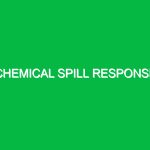Introduction
In an increasingly complex world where chemicals are integral to various industries, the labeling of hazardous substances has emerged as a critical focus in the realm of Health, Safety, and Environment (HSE). But what exactly does this involve? Labeling hazardous substances refers to the practice of clearly and accurately identifying chemicals that pose risks to health, safety, and the environment. This is not merely a bureaucratic requirement; it plays a crucial role in preventing accidents, promoting safe handling, and ensuring compliance with legal regulations.
Consider a scenario: a worker in a manufacturing plant inadvertently spills a chemical due to inadequate labeling. The consequences can be dire, ranging from immediate health risks to long-term environmental damage. By ensuring proper labeling, we can mitigate such risks significantly. This article delves into the intricacies of labeling hazardous substances, exploring associated risks, safety precautions, best practices, and the regulatory framework that governs this essential aspect of workplace safety.
Understanding Hazardous Substances
To grasp the importance of labeling, we first need to understand what constitutes a hazardous substance. These are materials that can pose significant risks to health, safety, or the environment. They can be classified into various categories, including:
Physical Hazards
These include substances that can cause fires, explosions, or other dangerous reactions. A classic example is flammable liquids like gasoline. Without clear labeling, the risks associated with such materials can escalate rapidly.
Health Hazards
These substances can cause acute or chronic health effects upon exposure. For instance, asbestos is notorious for its long-term health implications, including lung cancer. Proper labeling can warn individuals of the potential dangers and necessary precautions.
Environmental Hazards
Substances that can cause harm to the environment, such as toxic chemicals that contaminate soil or water, fall into this category. An illustrative case is the improper disposal of pesticides, which can have devastating effects on local ecosystems.
Potential Hazards and Risks Associated with Labeling of Hazardous Substances
The process of labeling hazardous substances is not without its challenges and risks. Inadequate or unclear labeling can lead to a range of hazards that are detrimental to both individuals and the environment.
Inadequate Information
One of the most significant risks associated with labeling is the lack of comprehensive information. Labels must include critical details such as chemical identity, hazard symbols, and safety precautions. For example, a label that omits the phrase “toxic” can mislead workers, leaving them unprepared to handle the substance safely.
Misinterpretation of Labels
Another risk arises when workers misinterpret the information on labels. This can happen due to unclear language or symbols. For instance, a worker might overlook a warning symbol indicating a carcinogenic substance simply because they are not familiar with the symbol’s meaning. This misinterpretation can result in serious health implications.
Inconsistent Labeling Practices
Inconsistent labeling practices across different facilities or jurisdictions can create confusion and increase the risk of accidents. For instance, a chemical may be labeled differently in one country compared to another, leading to miscommunication among international teams.
Safety Precautions and Best Practices
To mitigate the risks associated with labeling hazardous substances, certain precautions and best practices should be observed. Implementing these strategies can enhance safety and compliance within workplaces.
Comprehensive Training
Providing thorough training for employees is paramount. Workers should be educated about the different types of hazardous substances, the significance of labeling, and how to interpret labels correctly. A personal experience from a manufacturing plant illustrates this point: after a comprehensive training session, incidents involving hazardous substances decreased by 40%. This underscores the value of education in promoting safety.
Standardized Labeling Formats
Using standardized labeling formats can greatly reduce confusion. For instance, the Globally Harmonized System of Classification and Labelling of Chemicals (GHS) provides a set of internationally recognized standards that can help unify labeling practices. By adopting these standards, organizations can create a consistent understanding of hazards across borders.
Regular Audits and Updates
Conducting regular audits of labeling practices and updating labels as necessary is essential. Chemicals may undergo changes in their composition or regulations may evolve, necessitating updates. A case study from a chemical manufacturing company revealed that regular audits not only improved label accuracy but also fostered a culture of safety awareness among employees.
Clear Visibility and Accessibility
Labels should be prominently displayed and easily readable. This can be achieved by using bold fonts, contrasting colors, and durable materials that withstand the workplace environment. For instance, in a warehouse setting, labels placed at eye level on storage containers ensure that workers can quickly access necessary information.
Regulatory Framework Governing Labeling of Hazardous Substances
The labeling of hazardous substances is regulated by various laws and standards at both national and international levels. Understanding these regulations is crucial for compliance and safe practices.
Globally Harmonized System (GHS)
The GHS, developed by the United Nations, aims to standardize the classification and labeling of chemicals globally. It provides a framework for hazard classification, labeling, and safety data sheet (SDS) requirements. Organizations that adhere to GHS not only comply with international regulations but also enhance workplace safety.
Occupational Safety and Health Administration (OSHA)
In the United States, OSHA has established regulations for hazardous communication, which include requirements for labeling hazardous substances in the workplace. The OSHA Hazard Communication Standard (HCS) mandates that employers ensure labels are available on containers and that employees are trained to understand them.
Environmental Protection Agency (EPA)
The EPA regulates the labeling of hazardous waste and chemicals under various statutes, including the Resource Conservation and Recovery Act (RCRA). These regulations ensure that hazardous substances are labeled accurately to prevent environmental contamination.
Conclusion
In conclusion, the labeling of hazardous substances is a vital component of health, safety, and environmental practices within various industries. By understanding the risks associated with inadequate labeling, implementing safety precautions, and adhering to regulatory standards, organizations can significantly enhance workplace safety.
As we navigate the complexities of handling hazardous substances, let us remember that clear and accurate labeling is not just a regulatory obligation; it is a fundamental aspect of protecting lives and preserving our environment. With proper training, standardized practices, and a commitment to safety, we can create safer work environments for everyone.


